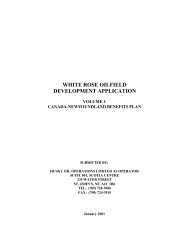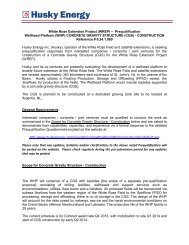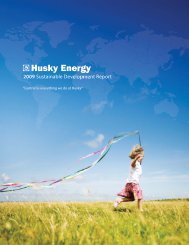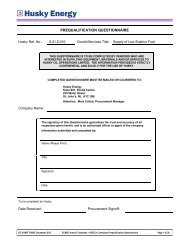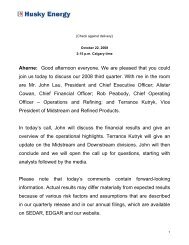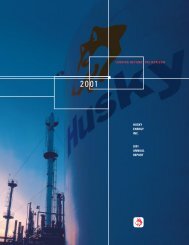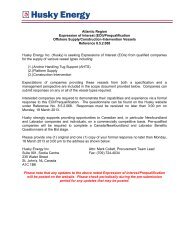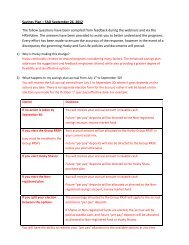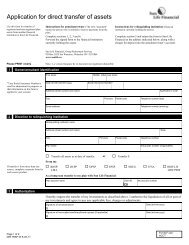white rose oilfield development application - Husky Energy
white rose oilfield development application - Husky Energy
white rose oilfield development application - Husky Energy
- No tags were found...
You also want an ePaper? Increase the reach of your titles
YUMPU automatically turns print PDFs into web optimized ePapers that Google loves.
6.1.3.3 Industrial and Commercial Land, Warehousing and Office SpaceThe dockyard in St. John’s covers approximately 7.5 ha (18.5 acres) at the western end of the Port of St.John’s. The dockyard is capable of providing a range of marine and offshore services. Its facilitiesinclude a graving dock, marine elevator, transfer and repair berths, mobile cranes, fabrication shops,warehousing and laydown areas. There are currently eight industrial parks in the St. John’s area, with atotal area of 464 ha (1,150 acres). Highway access from these industrial lands to other key infrastructureelements such as the Port of St. John’s and the St. John’s Airport is generally good. St. John’s andMount Pearl are the only communities in the study area with substantial amounts of commercialwarehouse space. Office space for administrative and <strong>development</strong> and operations-phase activities isfound mainly in St. John’s.The Bull Arm site represents the most significant industrial lands in the Isthmus area relevant to theoffshore industry. While the construction/administration area is closed, the fabrication and assemblyyard are currently in operation for the Terra Nova project. There are other industrial and commerciallands in the area with most concentrated in Clarenville and Arnold’s Cove.In Marystown, Friede Goldman Newfoundland Limited owns and operates the Marystown Shipyard,which handles boat construction and repair, refitting, conversion and maintenance for fishing fleet andoffshore-related vessels, as well as rig component construction and outfitting. The Cow Head facility,completed in the early 1990s, handles a variety of offshore construction contracts.6.1.4 FisheriesNewfoundland and Labrador’s fishing industry has undergone significant structural changes in the lastdecade following the closure of traditional groundfish fisheries, and is again highly viable. Among theGoods Industries in Newfoundland and Labrador, fisheries accounted for 35 percent of employment in1998 and ranked second only to oil production, mining and quarrying in terms of contribution to GDP.The number of people employed in fish harvesting in Newfoundland has remained relatively stable since1995. The annual average for 1999 was 8,700 employed, with peak employment at 10,300.The Grand Banks fisheries have undergone substantial change since the collapse of groundfish stocks.Groundfish (mostly northern cod) accounted for 63 percent of the catch by weight on the Grand Banksin 1987. In 1998, catches of snow crab, capelin, yellowtail flounder and redfish made up the bulk of thecatch (81 percent). Overall, the Grand Banks fishery was more lucrative in 1998 ($74 million landedvalue) than it was 11 years earlier (approximately $62 million). Grand Banks fisheries differ acrossNAFO Divisions (Figure 6.1-1) in terms of species harvested and their relative importance, landings,value and industry structure.White Rose DA Project Summary • January 2001 Page 89



